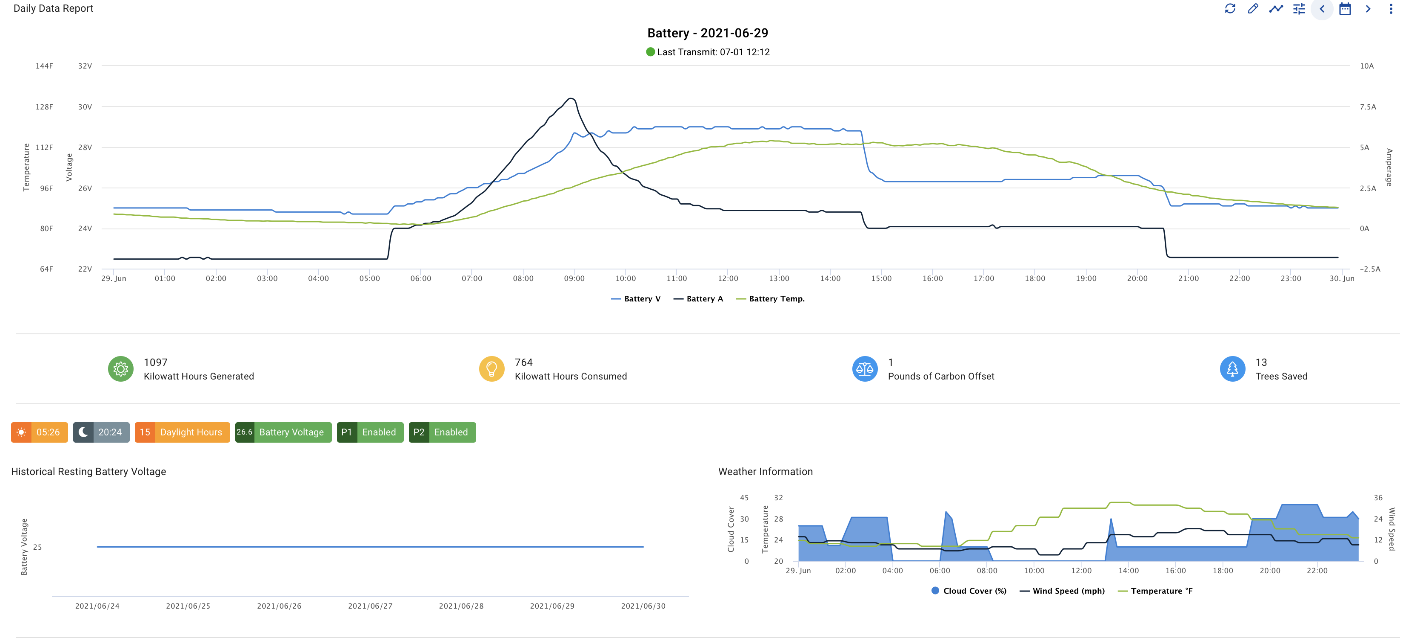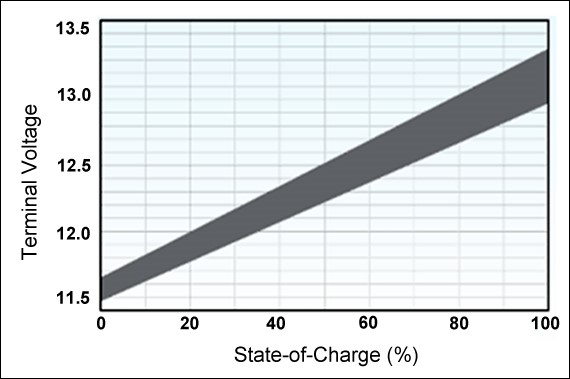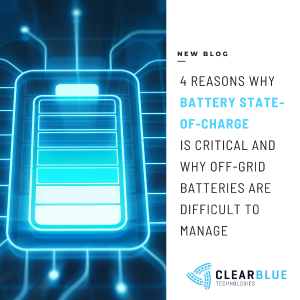4 Reasons Why Battery State of Charge is Critical and Why Off-Grid Batteries are Difficult to Manage
Advanced energy storage technologies are essential building blocks for a renewable energy future. Battery management is crucial to the delivery of reliable, cost-effective off-grid power, as batteries can be very easily damaged even during normal operation, thereby reducing their lifespan and the effectiveness of the power system. That is why knowing a battery’s capacity and its precise state of charge are crucial features in protecting the health of a battery and extending the life of a mission-critical off-grid power system. However, when it comes to batteries designed to support heavy loads such as telecommunications applications, calculating the state of charge is complicated by many practical and theoretical obstacles. Still, it can have major benefits for the overall power system’s cost, longevity and reliability. So why is it essential for off-grid power? Let’s find out.
1. Detect Trends
First, what is the purpose of having a battery gauge? Second, what can we do with the information it gives us? Our primary goal should be to use the information to identify and observe trends in the system, as this can help us understand how to manage energy usage best.
- How fast does the battery charge in each phase, and how quickly does it discharge?
- How much energy will be available at different times of the day?
- How much longer can the system operate on the life of this battery?

*This snapshot from Clear Blue’s Illumience software shows the battery’s performance and outside environmental conditions over a period of time.
2. Unmatched Energy Efficiency
By knowing the battery’s precise state of charge percentage, mission-critical power systems can be managed far more effectively. Knowledge of the battery state of charge indicates how long the system can continue to support the load. With this information, system downtime can be virtually eliminated. Also, alarms can be configured to notify users when the battery’s charge is approaching a high or a low level. From this, battery charging can be managed more efficiently. Thus, knowing the battery state of charge allows for optimal energy management. As a result, smaller power systems can still provide maximum uptime, even through periods of low solar energy generation. In addition, smaller systems allow for easier installation and lower upfront capital costs.
3. Extended System Life
In addition to battery life, the battery state of charge helps extend the life of the entire power system. Managing the charging cycles of batteries is an integral step in extending their life. If a battery is overcharged, this can significantly reduce its life. Likewise, if a battery is over-discharged, it will have a similar effect. By knowing the battery’s state of charge and receiving alerts when it reaches critical levels, battery life can be maximized, thereby extending and enhancing the system’s life. 
*This snapshot from Clear Blue’s Illumience software shows tracking of battery charging trends for battery state of charge.
Ultimately, by knowing the battery’s charge level, off-grid power can be made more intelligent by detecting trends in the system. A clear battery SOC allows us to have more knowledge about the system, manage it far more efficiently and extend its life.
4. Real-World Applications
This is Africa; this is LATAM; this is the U.S. Northeast, and this is the Canadian Midwest. Using data from real environments helps to efficiently manage systems in the field. In many cases, the manufacturer’s specifications have absolutely nothing to do with our real-world, extreme weather environments. Battery specifications do not accurately indicate how a battery will perform in the field. There is dust, and then there is African Dust. There are heat domes and days of nothing but rain. Harsh conditions such as these have a significant effect on how off-grid solar systems perform. Using real-world data from systems in the field, and having ongoing data on battery performance and state of charge, is key to making systems work in the field and not just in the lab. Understanding and using battery state of charge data not only helps improve the real-world performance of smart off-grid power systems, but it also helps improve the design and performance of future systems.
We have seen how vital battery state of charge can be for smart off-grid power systems, but if it is so valuable, why aren’t all off-grid systems looking at this? Unfortunately, many practical and theoretical obstacles that make batteries used in an off-grid power system, difficult to manage and the state of charge hard to pinpoint. For example, voltage is an unreliable measure of battery state of charge. Also, both temperature and age have a profound effect on the battery’s charge level.
Voltage Unreliability
On the practical side, we need to find a measurement that can be used to precisely calculate the state of charge. Although the voltage is a critical measurement for understanding how the battery is performing, it cannot be used to accurately calculate the state of charge for a lithium battery. For example, when a lithium-ion battery reaches a low voltage of 24.6V, the battery is actually approaching 0% charge. As well, in the span of 1.5V, the battery may go from 100% to 0%. This short window of notice provides little time to preserve the battery's health and avoid system downtime.
Also, voltage tends to drop suddenly, while state of charge decreases at a steady rate. As a result, when a system has a particular voltage, this could indicate an extremely wide range of charge levels. Most importantly, this range of charge can vary significantly based on the size of the load being powered, the battery manufacturer, and even the battery model. Below demonstrates the range of the state of charge at different voltages for a lead-acid battery. This range is even more drastic for lithium-ion batteries.

*This image shows how to measure the state of charge. Learn more.
Therefore, voltage does not help to estimate battery charge accurately. As the goal of battery state of charge is to manage the system effectively and reliably, it is clear that using voltage as a proxy for battery state of charge does little good.
Temperature Integration
Furthermore, there are theoretical obstacles that must be considered when calculating the battery state of charge. For all chemistries, but especially for lithium-ion batteries, the temperature of the battery affects what is known as the total usable battery capacity. Studies show that extremely high and low battery temperatures cause drastic reductions in the total usable capacity of the battery, known as derating. For example, at 60°C, the battery capacity is 80.63%, and at -10°C, the battery capacity is 85%. This temperature effect on the battery’s capacity heavily influences the calculation of state of charge. For example, a battery that is at 80% total usable capacity and a 50% charge will actually only have a 40% charge. Including the battery’s temperature when calculating its state of charge is thus crucial for pinpointing an accurate value.
Ageing Compensation
Likewise, battery ageing can also derate the battery’s total usable capacity and state of charge. As batteries age, their total usable capacity decreases, thereby complicating the calculation of state of charge in a similar way to the effects of temperature. Therefore, both temperature and age must be taken into account to come up with an accurate calculation of the battery’s charge level.
What can you do?
To better manage your off-grid power, you need to monitor and manage your batteries in the field and on an ongoing basis. Battery state of charge is the best way to provide the necessary insight for detecting trends, achieving energy efficiency and extending the system life. With an accurate battery gauge and advanced software that can account for voltage, temperature, and ageing factors, like Clear Blue’s Illumience, your system will achieve unmatched reliability and uptime. Battery state of charge is a standard feature of Clear Blue’s Smart Off-Grid power solutions. With this, you can trust that your mission-critical system will operate with the highest reliability and have the longest life, ultimately saving you money on maintenance and replacement costs.


